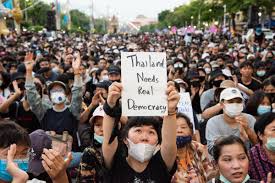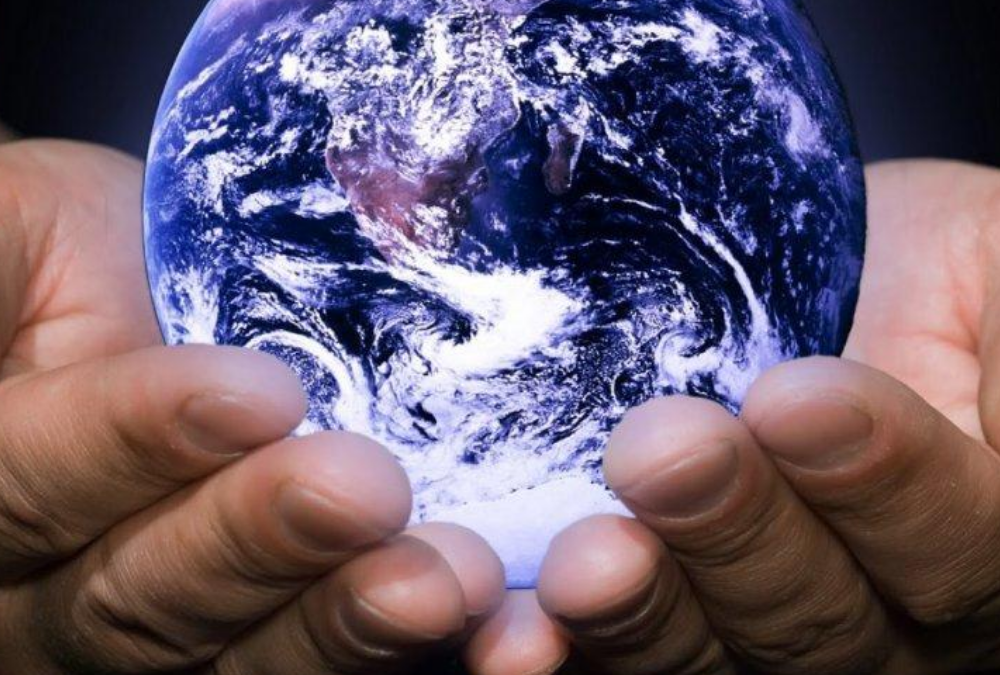
Chaz BurtonDec 25, 2020Sustainability
การประท้วงของนักเรียนนักศึกษาไทย http://www.terrapromus.org/wp-content/uploads/2020/12/Thai-Student-Protests-w-Thai-Subtitles-1.mp4 การประท้วงของนักศึกษาไทยและการเคลื่อนไหวประท้วงของเยาวชนทั่วโลก: ความเสมอภาคสำหรับทุกคนหรือเพียงแค่เพื่อมนุษย์? การประท้วงของนักเรียนไทย – คืออะไรกันแน่ ? และเชื่อมโยงกับการประท้วงของเยาวชนต่างๆทั่วโลกอย่างไร? ในช่วงเก้าปีที่ผ่านมานับตั้งแต่ปรากฏการณ์อาหรับสปริง(link) มีการประท้วงของเยาวชนในซูดาน เลบานอน อิรัก ฮ่องกง เฮติเซเนกัล สเปน และตอนนี้เบลารุส คนหนุ่มสาวทั่วโลกตระหนักถึงความไม่เท่าเทียมกันทางเศรษฐกิจและสังคมและเรียกร้องความเท่าเทียมกัน การประท้วงเหล่านี้เป็นการท้าทายการกดขี่ ควบคุมจิตสำนึก มีความพยายามที่ประสานกันเพื่อไม่ให้ผู้คนผิดหวัง ปิดกั้นการรับรู้ การเป็นเจ้าของและการแสดงพลังของพวกเขา และด้วยเหตุนี้เพื่อเรียกร้องสิทธิมนุษยชนโดยธรรมชาติของพวกเขา การประท้วงที่หลากหลายเหล่านี้ล้วนเกี่ยวกับสิ่งพื้นฐานเดียวกันนั่นคือความเสมอภาค – แต่การประท้วงด้านสิ่งแวดล้อมของเยาวชนทั่วโลกซึ่งมีจำนวนมากกว่าเศรษฐกิจและสังคมล่ะ? กลุ่มต่างๆเช่น School Strike Movement (Fridays for Future), Extinction Rebellion, Greenpeace, 350.org และอื่น ๆ อีกมากมายกำลังเรียกร้องให้ยุติการทำลายสิ่งแวดล้อมและเป็นจุดเริ่มต้นของการดูแลสิ่งแวดล้อม การเคลื่อนไหวเหล่านี้มีความแตกต่างกันโดยมีจุดมุ่งหมายต่างกันหรือไม่? เมื่อมองแวบแรกอาจมีคนคิดอย่างนั้น แต่เมื่อเรามองเข้าไปใกล้จะเห็นได้ชัดว่าพวกเขามีเป้าหมายพื้นฐานเดียวกันนั่นคือความเท่าเทียมกันของโลกและสิ่งมีชีวิตทั้งหมด ไม่ใช่แค่มนุษย์ เราเชื่อในอำนาจสูงสุดของมนุษย์ ถ้าเราต้องการห้างใหม่เราก็แค่ควักพื้นที่ไม่กี่เอเคอร์ปูทับและสร้างห้างสรรพสินค้า เรียบง่าย ไม่มีปัญหาใช่มั้ย? ไม่ถูกต้อง; เราเพิ่งทำลายระบบนิเวศทั้งหมดและสิ่งมีชีวิตนับพัน หลายร้อยหลายพันความเจริญรุ่งเรือง ชุมชนที่เชื่อมต่อระหว่างกันถูกทำลาย จากได้ไปแล้ว ตลอดกาล เรามีสิทธิ์มั้ย? แน่นอนเรามีสิทธิ์ ไปสู่ความคิดแบบเดิม ๆ เราทำมาตลอดและทำมาตั้งแต่ที่มนุษย์เริ่มที่มีอารยธรรม เราปล้นและปล้นสะดมทุกสิ่งที่เราต้องการ ทั้งหมดทั้งมวล นั่นเพราะ เราเป็นสายพันธุ์ที่เหนือกว่า หรือไม่ใช่? แน่นอนว่าผู้คนจำนวนมากขึ้นกำลังตระหนักว่านี่ไม่ใช่แค่ความเชื่อที่ผิดเท่านั้น แต่ยังเป็นการทำลายตัวเองด้วยเช่นกัน เราขึ้นอยู่กับความหลากหลายทางชีวภาพของสิ่งมีชีวิตบนโลก ความหลากหลายของชีวิตที่เรากำลังทำลายคือการทำลายโอกาสในการอยู่รอดของเราเอง แต่มากกว่าแค่การอยู่รอดยังมีคำถามทางจริยธรรม ซึ่งจะขอกล่าวอีกครั้งหนึ่ง คือ ความเสมอภาค พระพุทธเจ้าตระหนักถึงสิ่งนี้และขอร้องให้สาวกของเขาไม่ทำร้ายสิ่งมีชีวิต เมื่อเราอนุญาตให้สรรพสัตว์มีสิทธิที่จะมีชีวิตและเจริญงอกงามเราได้เตือนตัวเองถึงศักดิ์ศรีและความเป็นมนุษย์ที่แท้จริงของเรา เป็นเรื่องน่ายินดีอย่างยิ่งที่ได้เห็นคนหนุ่มสาวลุกขึ้นมามีอำนาจของตนเองและใช้สิ่งนี้เพื่อเรียกร้องสิทธิมนุษยชนโดยกำเนิดของตน วิธีที่สำคัญที่สุดวิธีหนึ่งที่การประท้วงที่แตกต่างกันแต่เป็นปึกแผ่นเหล่านี้สามารถจัดขึ้น ประท้วง และดำเนินการอารยะขัดขืนอื่นๆได้อย่างประสบความสำเร็จและยั่งยืนคือการเรียนรู้จากกันและกัน และการเรียนรู้การเคลื่อนไหวประท้วงและองค์กรที่ประสบความสำเร็จตั้งแต่อดีตจนถึงปัจจุบัน เช่นเดียวกับการเคลื่อนไหวด้านสิทธิพลเมืองและการปลดปล่อยสตรี(the Civil Rights and Women’s Liberation Movements,) กรีนพีซ(Greenpeace) ขบวนการต่อต้านนิวเคลียร์(the Anti-Nuclear Movement) และตอนนี้กบฏต่อต้านการสูญพันธุ์(Extinction Rebellion), ขบวนการสไตรค์ของโรงเรียน(the School Strike Movement) และ 350.org แต่ละการตัวอย่างล้วนมีบทเรียนล้ำค่าที่จะบอกเล่า และกลยุทธ์ที่จะแบ่งปัน ขอให้เราเข้าใจอย่างชัดเจนว่าการต่อสู้ในรูปแบบใดก็ตาม – การเคลื่อนไหวทางเศรษฐกิจสังคมหรือสิ่งแวดล้อมล้วนเป็นไปเพื่อสิ่งเดียวกันนั่นคือโลกที่เท่าเทียมและยั่งยืนมากขึ้น และขอให้เราผนึกกำลังและร่วมมือกันยืนหยัดอย่างเข้มแข็งและภาคภูมิใจในสิ่งที่เรารู้อย่างลึกและตรึงอยู่ในใจเรา ถึงเวลาแล้วสำหรับความยุติธรรมและความยุติธรรม! Links: Protests around the world explained https://www.amnesty.org/en/latest/news/2019/10/protests-around-the-world-explained/ Do today’s global protests have anything in common? https://www.bbc.com/news/world-50123743 Learning from Successful Movements http://effectiveactivist.com/movement-success/ Activist Campaign Tactics (at end of each section, click for next section) http://effectiveactivist.com/tactics/ How Protests Become Successful Social Movements https://hbr.org/2017/01/how-protests-become-successful-social-movements Lessons from the Civil Rights Movement https://www.humanityinaction.org/knowledge_detail/lessons-from-the-civil-rights-movement-reflections-on-the-long-movement-for-black-liberation-from-atlanta-to-amsterdam/ Women’s Liberation Movement https://www.lse.ac.uk/library/collection-highlights/womens-liberation-movement Fridays for Future: why the movement is successful https://www.deutschland.de/en/topic/politics/fridays-for-future-why-the-movement-is-successful Greenpeace’s Campaign Strategies http://peacemagazine.org/archive/v20n3p13.htm Extinction Rebellion’s Path to Success https://www.nytimes.com/2019/10/08/world/europe/extinction-rebellion-london-greta.html 350.org Resources for Organizers https://trainings.350.org/for/organisers/ ...

Chaz BurtonOct 17, 2020Sustainability
The Thai Student Protest and the Global Youth Protest Movement: Equity for all, or just humans? The Thai student protests – what exactly are they? And how are they connected to the many other youth protests around the world? In a word: equity. http://www.terrapromus.org/wp-content/uploads/2020/10/Thai-Student-Protests-w-Intro-and-Outro.mp4 In the last nine years since the Arab Spring (link), there have been and/or are youth protests in Sudan, Lebanon, Iraq, Hong Kong, Haiti, Senegal, Spain and now Belarus. Young people around the world are recognizing the vast economic and social inequalities and demanding equality. These protests are challenging oppression; conscious, coordinated efforts to keep people down, keeping them from recognizing, owning and expressing their power, and thereby to claim their inherent human rights. All these diverse protests are about the same fundamental thing – equity – but what about the global youth environmental protests, which are even more numerous than the economic and social ones? Groups such as the School Strike Movement (Fridays for Future), Extinction Rebellion, Greenpeace, 350.org and many others, are demanding an end to environmental destruction and a beginning of environmental stewardship. Are these movements essentially different, with different aims? At first glance, one might think so, but when we look closer, it is clear they share the same fundamental goal: equity for the Earth and all of her creatures, not just humans. We have come to believe in the supremacy of humans; if we want a new mall, we just bulldoze a few acres, pave over it and build a mall. Simple. No problem, right? Wrong; we have just destroyed an entire ecosystem, and thousands of creatures. Hundreds if...

Chaz BurtonMay 27, 2020Sustainability
If nothing else, Bernie Sanders, Vermont Senator and democratic presidential candidate, has started a new conversation in America, one which was largely shunned previously. America is now talking about democratic socialism; what it is, isn’t and how it might offer an alternative to the capitalism, which is clearly not working, for the majority of people nor the environment. Most base their ideas and attitudes about socialism from the stigma it has gained over the course of American history, particularly since the cold war. When people think of socialism, they think of the Soviet Union, Cuba or Venezuela, none of which were or are truly socialist governments. The best examples are many of the northern European countries, like Sweden, Norway and Denmark; these countries have higher taxes than most purely capitalist countries, yet have high quality, universal health care and education, low crime rates and a far higher levels of happiness among their citizens. In contrast, the U.S., the richest country on earth, has a troubled education system and is slipping in international measures of educational outcomes (PISA), a dysfunctional health care system in which 30 million people do not have health insurance, high levels of crime and gun use, the largest prison population in the world and is not only refusing to cooperate with the world in dealing with climate change but, thanks to Trump, is dismantling environmental laws and policies and increasing its greenhouse gasses which lead to climate change. Yet the U.S. is still called the leader of the free world? What kind of a world? These problems are clearly linked to inequity; the control of...

Chaz BurtonMay 26, 2020Sustainability
伯尼之殇 星星之火可燎原 如果没有别的,佛蒙特州参议员、民主党总统候选人伯尼·桑德斯(Bernie Sanders)在美国开始了一场新的对话,而这场对话以前基本上是被回避的。美国现在谈论的是民主社会主义;“它是什么,不是什么,”以及它如何为大多数人和环境提供一个明显不起作用的资本主义的替代品。 大多数人对社会主义的看法和态度是建立在它在美国历史上,特别是冷战以来所蒙受的耻辱之上的。人们一想到社会主义,就会想到苏联、古巴或委内瑞拉,它们都不是或都不是真正的社会主义政府。最好的例子是许多北欧国家,如瑞典、挪威和丹麦;这些国家的税收比大多数纯粹的资本主义国家高,但却有高质量、普遍的医疗保健和教育、低犯罪率和公民的幸福感要高得多。 相比之下,美国这个地球上最富有的国家,教育系统有问题,国际教育成果衡量标准(PISA)也在下滑,这是一个功能失调的医疗体系,3000万人没有医疗保险,犯罪率高,使用枪支,世界上监狱人口最多,不仅拒绝与世界合作应对气候变化,而且由于特朗普,正在废除环境法律和政策,增加导致气候变化的温室气体。然而,美国仍然被称为自由世界的领袖?什么样的世界? 这些问题显然与不平等有关;由贪婪和恐惧的精英控制哪些应该作为我们的共同资源加以保护和保护,而牺牲了大多数人的利益。26个最富有的人拥有世界上最贫穷的50%的土地。与此同时,每天有25000人死于饥饿,每年有900万人死于饥饿。我们共同的水、天空和土壤遗产正受到公司的毒害,他们非常有意识地和恶意地将废物倾倒到我们的环境中。大规模的风暴、火灾和其他极端天气事件正在造成大规模的全球破坏,造成数以百万计的“气候避难所”。数亿人或人民由于无知和不容忍而遭受压迫、歧视和虐待,主要是基于右翼精英的宣传,他们的主要目标是在我们中间制造分裂。像罗马人一样,他们寻求“分而治之” “这一切都不可避免吗?“ 由于联合国应对气候变化组织IPCC在2019年底发布了一份报告,该组织由来自世界几乎每个国家的气候科学家组成,他说,世界还有12年的时间来应对气候变化,要认真减少我们的温室气体排放,防止全球气温持续可怕的上升。然而,在每年一度的联合国全球气候变化大会COP25上,数据显示,排放量和气温都在增加。尽管发出了种种可怕的警告,但气候变化的所有最大贡献者都在朝着需要的相反方向发展。 政府没有采取行动。他们表现得像被宠坏的孩子,拒绝停止吃糖,直到生病呕吐到客厅地板上。这就是格雷塔·图伯格成为世界各地年轻气候活动家的拥护者的原因。她已经召集了世界领导人,要求他们表现得像他们应该成为的成年人一样,并对减少排放保持严肃态度。她甚至在联合国大会的演讲中愤怒地斥责这些政府官员。她的勇敢鼓舞了数以百万计的全球青年气候活动家,他们现在参与了无数形式的活动,要求他们的政府开始采取行动阻止气候变化。 这正是伯尼所做的;美国的年轻人对这种缺乏行动以及由此引发的全球气候灾难感到沮丧和失望。他们看到了经济不平等和4880万美国人,包括1620万儿童,遭受饥饿和营养不良的事实。他们担心4400万人没有医疗保险,3800万人没有足够的医疗保险,这意味着每年有数万人因为负担不起去看医生而死亡。他们对右翼精英的种族主义、歧视政策和做法感到震惊,他们排斥和压迫妇女、有色人种和同性恋者。 大约60%的35岁以下的美国人支持伯尼,因为他对如何解决这些巨大问题的想法。他迫使美国人调查、剖析和分析社会主义,并思考它如何比资本主义更公平、更有效地为美国人服务,这是大多数年轻人和我们许多老前辈在挖掘媒体助长的错误信息时发现的 大约60%的35岁以下的美国人支持伯尼,因为他对如何解决这些巨大问题的想法。他迫使美国人调查、剖析和分析社会主义,并思考它如何比资本主义更公平、更有效地为美国人服务。大多数年轻人和我们许多老前辈在挖掘媒体助长的对社会主义的误解时发现,这是基于卡尔·马克思的平等主义思想,这种思想设想的尊严和平等远远高于资本主义的“狗咬狗”制度。共同所有制和决策以及经济和社会平等、普遍的儿童保健、由于更大的社会和经济压迫而减少犯罪。更清洁的环境是因为环境政策和法律是由大多数人制定的,而不是由贪婪无耻的精英制定的。对不起,这里有什么不喜欢的?只有那些希望看到我们挣扎和分裂的人的谎言,使我们没有抵抗和反对他们邪恶计划的力量和手段。...

Chaz BurtonApr 3, 2020Sustainability
This project is inspired heavily by one of my greatest mentors and sources of inspiration, Joanna Macy, based on her work of “spiritual activism.” She is among the many people teachers and writers who have used their experience and practice of Buddhist principles and practices to inform and guide their work. In her book Coming Back to Life, (2014) (https://workthatreconnects.org/resource/coming-back-to-life-the-updated-guide/) she describes the shift from the Industrial Growth Society (IGS) to a “Life-sustaining society.” This has subsequently become known as The Great Turning. (http://www.videoproject.com/thegreatturning.html) This is “an extraordinary moment on Earth,” she proclaims, yet one which is also scary, stressful and sad. There is so much evidence of environmental destruction and human suffering. In order to regain confidence, hope and joy, it is necessary that we first squarely face this destruction and suffering, and the pain and grief it causes. Many people around the world are doing this, but there is a critical next step: we need to acknowledge that the pain and grief not just “out there,” but deeply embedded within our own psyches, and bodies. It’s as if the instinctual, animal part of us feels the tortured screams of nature as she is raped and pillaged. Yet this is a cultural taboo; there is a deep unconscious agreement to not be seen as “negative,” to put on our happy faces, and to pretend like nothing is happening. Or at least act as if things are not that bad, right? This is what Macy describes as Business as Usual. In addition to the societal pressure to “not go there,” there is an instinctual fear of letting ourselves grieve...

Chaz BurtonMar 11, 2020Sustainability
By now, most young people know of the threat of climate change and the need to make significant changes in our lifestyles. However, far fewer actually make those changes. Why? If, Greta Thunberg says, our house is burning down, why do we still act as if climate change is a threat to be worried about in some distant future? If our house was literally burning down and our grandmother and son were sleeping in their bedrooms, would we keep doing our homework, watching TV or browsing Line or Facebook? Of course not; we would jump up, yelling, gather everyone and get the shenanigans out of the house! So, again, why don’t we change? Simple. Because we don’t really BELIEVE that it is an urgent enough problem. Let’s face it: we all resist change; it is part of human nature to do so. We want stability, things to be the same, yet, of course, the one constant in life is change. We either change or we die, or become completely ineffective or irrelevant. The trick is to change deliberately and gracefully, so that change is not forced upon us and our lives become turmoil. How? Again, simple, but not easy. We become conscious of the changes coming, and of the power fueling the change, and choose to align ourselves with that power. Here are some examples of young people who have done just this, and who are shining examples of inspiring the kinds of changes that are producing strong and specific models of fierce yet compassionate activism. https://www.youtube.com/watch?v=-jE_mvr4U_A&t=172 https://www.reuters.com/article/us-climate-change-strike-thailand/young-climate-strikers-drop-dead-at-thai-environment-ministry-idUSKBN1W509Y https://www.youtube.com/watch?v=jOxjFnnsCkw ...







